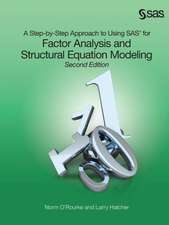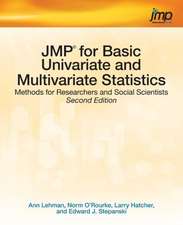Using SPSS for Windows: Data Analysis and Graphics
Autor Susan B. Gerber, Kristin Voelkl Finnen Limba Engleză Paperback – 25 mar 2005
Preț: 362.94 lei
Preț vechi: 453.68 lei
-20% Nou
Puncte Express: 544
Preț estimativ în valută:
69.46€ • 75.42$ • 58.34£
69.46€ • 75.42$ • 58.34£
Carte tipărită la comandă
Livrare economică 22 aprilie-06 mai
Preluare comenzi: 021 569.72.76
Specificații
ISBN-13: 9780387400839
ISBN-10: 0387400834
Pagini: 228
Ilustrații: XII, 228 p. 95 illus.
Dimensiuni: 178 x 254 x 15 mm
Greutate: 0.48 kg
Ediția:2nd ed. 2005
Editura: Springer
Colecția Springer
Locul publicării:New York, NY, United States
ISBN-10: 0387400834
Pagini: 228
Ilustrații: XII, 228 p. 95 illus.
Dimensiuni: 178 x 254 x 15 mm
Greutate: 0.48 kg
Ediția:2nd ed. 2005
Editura: Springer
Colecția Springer
Locul publicării:New York, NY, United States
Public țintă
Professional/practitionerCuprins
The Nature of SPSS.- Summarizing Data Graphically.- Summarizing Data Numerically: Measures of Central Tendency.- Summarizing Data Numerically: Measures of Variability.- Summarizing Multivariate Data: Association Between Numerical Variables.- Summarizing Multivariate Data: Association Between Categorical Variables.- Basic Ideas of Probability.- Probability Distributions.- Sampling Distributions.- Answering Questions About Population Characteristics.- Differences Between Two Populations.- Inference on Categorical Data.- Regression Analysis: Inference on Two or More Numerical Variables.- ANOVA: Comparisons of Several Populations.- Exploratory Factor Analysis.
Recenzii
From a review:
THE AMERICAN STATISTICIAN
"The authors write well, and most concepts are explained clearly.
From the reviews of the second edition:
"It is a clearly written guide, suitable for undergraduates or maybe Masters level students with no prior experience of statistical analysis. The basic, important and necessary areas, such as probability, sampling, regression and analysis of variance are included, with enough detail (and reproduction of SPSS dialogue boxes and windows for up to version 13) to make the whole thing easy to follow." (Amanda Root, Journal of the Royal Statistical Society, Vol. 169 (4), 2006)
THE AMERICAN STATISTICIAN
"The authors write well, and most concepts are explained clearly.
From the reviews of the second edition:
"It is a clearly written guide, suitable for undergraduates or maybe Masters level students with no prior experience of statistical analysis. The basic, important and necessary areas, such as probability, sampling, regression and analysis of variance are included, with enough detail (and reproduction of SPSS dialogue boxes and windows for up to version 13) to make the whole thing easy to follow." (Amanda Root, Journal of the Royal Statistical Society, Vol. 169 (4), 2006)
Textul de pe ultima copertă
The second edition of this popular guide demonstrates the process of entering and analyzing data using the latest version of SPSS (12.0), and is also appropriate for those using earlier versions of SPSS. The book is easy to follow because all procedures are outlined in a step-by-step format designed for the novice user. Students are introduced to the rationale of statistical tests and detailed explanations of results are given through clearly annotated examples of SPSS output. Topics covered range from descriptive statistics through multiple regression analysis. In addition, this guide includes topics not typically covered in other books such as probability theory, interaction effects in analysis of variance, factor analysis, and scale reliability. Chapter exercises reinforce the text examples and may be performed for further practice, for homework assignments, or in computer laboratory sessions.
This book can be used in two ways: as a stand-alone manual for students wishing to learn data analysis techniques using SPSS for Windows, or in research and statistics courses to be used with a basic statistics text. The book provides hands-on experience with actual data sets, helps students choose appropriate statistical tests, illustrates the meaning of results, and provides exercises to be completed for further practice or as homework assignments.
Instructions are provided for using the World Wide Web to obtain the data sets to be analyzed. With this guide, students learn how to conduct reasonably sophisticated statistical analyses using SPSS while gaining insight into the nature and purpose of statistical investigation.
Susan B. Gerber, Ph.D. is Assistant Professor of Education at State University of New York at Buffalo. She is director of the Educational Technology program and holds degrees in Statistics and Educational Psychology.
Kristin Voelkl Finn, Ph.D. is Assistant Professor of Education at Canisius College. She teaches graduate courses in research methodology and conducts research on adolescent problem behavior.
This book can be used in two ways: as a stand-alone manual for students wishing to learn data analysis techniques using SPSS for Windows, or in research and statistics courses to be used with a basic statistics text. The book provides hands-on experience with actual data sets, helps students choose appropriate statistical tests, illustrates the meaning of results, and provides exercises to be completed for further practice or as homework assignments.
Instructions are provided for using the World Wide Web to obtain the data sets to be analyzed. With this guide, students learn how to conduct reasonably sophisticated statistical analyses using SPSS while gaining insight into the nature and purpose of statistical investigation.
Susan B. Gerber, Ph.D. is Assistant Professor of Education at State University of New York at Buffalo. She is director of the Educational Technology program and holds degrees in Statistics and Educational Psychology.
Kristin Voelkl Finn, Ph.D. is Assistant Professor of Education at Canisius College. She teaches graduate courses in research methodology and conducts research on adolescent problem behavior.
Caracteristici
All procedures and examples are outlined in a step-by-step format, and results produced by SPSS are shown and discussed in each application Users conduct reasonably sophisticated statistical analyses using SPSS while gaining insight into the nature and purpose of statistical investigation Topics cover a wide range-from descriptive statistics through multiple regression, including probability theory Additional data sets to be analyzed are available via the www Includes supplementary material: sn.pub/extras
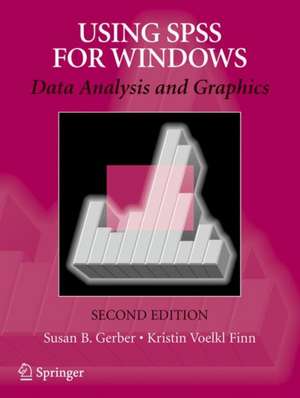



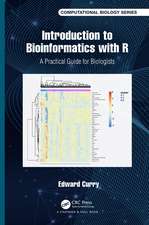
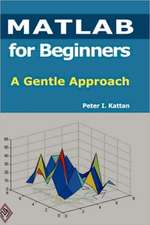

![Carpenter's Complete Guide to the SAS Report Procedure [With CDROM]](https://i0.books-express.ro/bt/9781599941950/carpenter-s-complete-guide-to-the-sas-report-procedure-with-cdrom.jpg)
